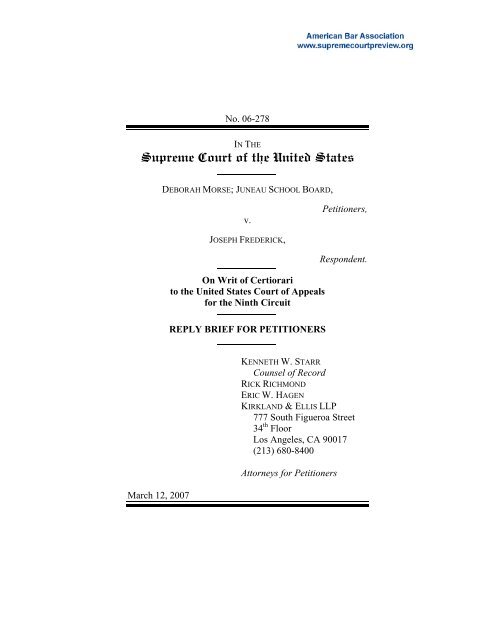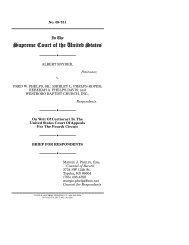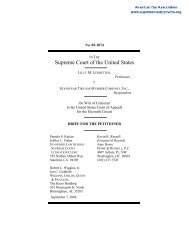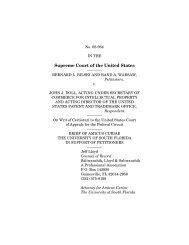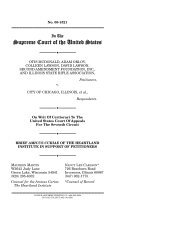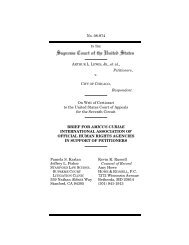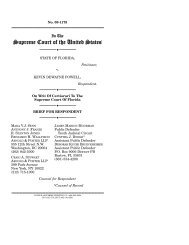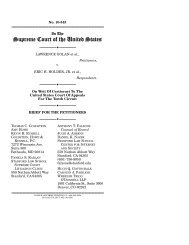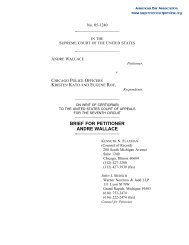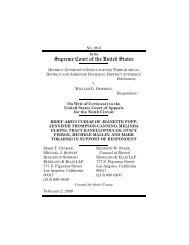Reply Brief for Petitioner Deborah Morse - Oyez
Reply Brief for Petitioner Deborah Morse - Oyez
Reply Brief for Petitioner Deborah Morse - Oyez
Create successful ePaper yourself
Turn your PDF publications into a flip-book with our unique Google optimized e-Paper software.
No. 06-278IN THESupreme Court of the United StatesDEBORAH MORSE; JUNEAU SCHOOL BOARD,v.<strong>Petitioner</strong>s,JOSEPH FREDERICK,On Writ of Certiorarito the United States Court of Appeals<strong>for</strong> the Ninth CircuitRespondent.REPLY BRIEF FOR PETITIONERSMarch 12, 2007KENNETH W. STARRCounsel of RecordRICK RICHMONDERIC W. HAGENKIRKLAND & ELLIS LLP777 South Figueroa Street34 th FloorLos Angeles, CA 90017(213) 680-8400Attorneys <strong>for</strong> <strong>Petitioner</strong>s
iTABLE OF CONTENTSPageTABLE OF AUTHORITIES........................................................iiI. THIS IS A STUDENT SPEECH CASE. ......................... 4II. PETITIONERS DID NOT VIOLATE THE FIRSTAMENDMENT BY DISCIPLININGRESPONDENT FOR PROMOTING ILLEGALSUBSTANCES AT A SCHOOL EVENT. .................... 10A. In the context of constitutional assurancesagainst unfettered discretion, public schoolauthorities may restrict student speech thatundermines the “basic educational mission.”........... 10B. Student speech that promotes illegal drug use isnot protected in the public high schoolenvironment.............................................................. 13C. School officials must have authority toreasonably interpret student expression in itscontext. ..................................................................... 16III. PRINCIPAL MORSE IS ENTITLED TOQUALIFIED IMMUNITY............................................. 18CONCLUSION .......................................................................... 20
iiCasesTABLE OF AUTHORITIESPage(s)Anderson v. Creighton,483 U.S. 635 (1987) .................................................22Bd. of Educ. v. Pico,457 U.S. 853 (1982) .............................................2, 14Bethel Sch. Dist. No. 403 v. Fraser,478 U.S. 675 (1986) ..........................................passimBlackwell v. Issaquena County Bd. of Educ.,363 F.2d 749 (5th Cir. 1966)....................................12Boroff v. Van Went City Bd. of Educ.,220 F.3d 465 (6th Cir. 2000)....................................17Brandenburg v. Ohio,395 U.S. 444 (1967) .................................................18Brandt v. Bd. of Educ.,Nos. 06-1999, 06-2573, 2007 WL 641516(7th Cir. Feb. 20, 2007) ............................................18Burnside v. Byars,363 F.2d 744 (5th Cir. 1966)....................................12Chandler v. McMinnville Sch. Dist.,978 F.2d 524 (9th Cir. 1992)....................................17Denno v. Sch. Bd. of Volusia County,218 F.3d 1267 (11th Cir. 2000)................................12
iiiEisner v. Stam<strong>for</strong>d Bd. of Educ.,440 F.2d 803 (2d Cir. 1971).....................................12Good News Club v. Mil<strong>for</strong>d Cent. Sch.,533 U.S. 98 (2001) ...................................................14Goss v. Lopez,419 U.S. 565 (1975) .............................................2, 14Graver Tank & Mfg. Co. v. Linde Air Prods. Co.,336 U.S. 271 (1949) .................................................10Hazelwood Sch. Dist. v. Kuhlmeier,484 U.S. 260 (1988) ..........................................passimMalley v. Briggs,475 U.S. 335 (1986) ...........................................20, 21McCann v. Fort Zumwalt Sch. Dist.,50 F. Supp. 2d 918 (E.D. Mo. 1999)..........................7Muller by Muller v. Jefferson Lighthouse Sch.,98 F.3d 1530 (7th Cir. 1996)....................................12Nicholson v. Bd. of Educ. Torrance Unified Sch. Dist.,682 F.2d 858 (9th Cir. 1982)....................................21Pyle By & Through Pyle v. S. Hadley Sch. Comm.,861 F. Supp. 157 (D. Mass. 1994)............................19Santa Fe Indep. Sch. Dist. v. Doe,530 U.S. 290 (2000) .................................................13Saxe v. State Coll. Area Sch. Dist.,240 F.3d 200 (3d Cir. 2001).................................2, 14
ivSchenck v. United States,249 U.S. 47 (1919) ...................................................19Thomas v. Bd. of Educ.,607 F.2d 1043 (2d Cir. 1979).....................................7Tinker v. Des Moines Cmty. Sch. Dist.,393 U.S. 503 (1969) ..........................................passimUnited States v. Lanier,520 U.S. 259 (1997) .................................................21W. Va. State Bd. of Educ. v. Barnette,319 U.S. 624 (1943) ...................................................2Williams v. Spencer,622 F.2d 1200 (4th Cir. 1980)......................15, 17, 21Wilson v. Layne,526 U.S. 603 (1999) .................................................21School District RulesJuneau School Board Policy 1240..........................................2Juneau School Board Policy 5520....................................7, 19Juneau School Board Policy 5600..........................................7Juneau School Board Policy 5850......................................6, 7
vOther AuthoritiesAllan E. Korpela, Annotation, Tort liability of publicschools and institutions of higher learning <strong>for</strong>injuries resulting from lack or insufficiency ofsupervision, 38 A.L.R.3d 830 (1971 & Supp.2007)...........................................................................9Revathy Kumar et al., Effects of School-Level Norms onStudent Substance Abuse, 3 Prevention Sci. 105(June 2002)...............................................................14Motion Picture Ass’n of Am., What do the ratingsmean?, available athttp://mpaa.org/FlmRat_Ratings.asp........................153 James A. Rapp, Education Law (2006)...............................7
1Respondent and his amici do not quarrel with theproposition that advocating illegal drug use by minors is outof place in our nation’s public schools. To the contrary, theyaccept the schools’ fundamental interest in discouraging theuse of illegal substances. Resp. Br. at 6 (“There is no disputethat schools have an important message to deliver regardingthe perils of drug abuse.”); see, e.g., ACLJ Amicus Br. at 10-11 (“The physical and emotional vulnerability of youth . . .can justify more intrusive measures to detect and halt drugabuse.”). 1Nevertheless, respondent and his amici suggest thatpetitioners have imposed a “pall of orthodoxy” over theJuneau-Douglas High School by prohibiting messages thatpromote illegal drug use. Resp. Br. at 12. They aremistaken. The same Juneau School Board policy thatprohibits advocacy of illegal drug use explicitly recognizesthat “[s]tudents will not be disturbed in the exercise of theirconstitutionally guaranteed rights to assemble peaceably andto express ideas and opinions.” Pet. App. 53a. Likewise, theSchool Board embraces students’ rights to “explore fully andfairly all sides of . . . controversial issues.” Juneau Sch. Bd.Policy 1240, available at http://www.jsd.k12.ak.us/1 See also Drug Policy Alliance Amicus Br. at 29 (acknowledging “theinestimable seriousness of the problem of youth drug abuse”); LibertyLegal Inst. Amicus Br. at 14 (“The use of drugs is a criminal offense, andwhatever disagreement there may be about the efficacy of the drug laws,or about the need <strong>for</strong> laws against adult use of the less dangerous illegaldrugs, there is overwhelming consensus in the polity that adults shoulddiscourage children from using drugs.”); Nat’l Coal. Against CensorshipAmicus Br. at 7 (“Amici curiae share <strong>Petitioner</strong>s’ and the Government’scommitment to promoting the health and well-being of our nation’s youthby discouraging illegal drug use . . . .”)’ Ruther<strong>for</strong>d Inst. Amicus Br. at 27(noting “the dangers and perils of drug use”); Students <strong>for</strong> Sensible DrugPolicy Amicus Br. at 9 (“Students often experience disproportionate painin seeing family members, friends, and classmates suffer from drugabuse.”).
2newdistrict/departments/boardofeducation/policymanual/_displayPolicy.php?recid=13. 2Under no reasonable interpretation of this record werepetitioners suppressing discourse over drug policy or anyother political, religious, or ideological issue—in or out ofthe classroom. Nor are Juneau’s student conduct ruleschallenged as overbroad or vague. Cf. Saxe v. State Coll.Area Sch. Dist., 240 F.3d 200, 214 (3d Cir. 2001) (Alito, J.). 3This case is also far removed from freedom-of-conscienceconcerns, cf. W. Va. State Bd. of Educ. v. Barnette, 319 U.S.624 (1943), or attempts to restrict access to books oreducational materials. Cf. Bd. of Educ. v. Pico, 457 U.S. 853(1982). Rather, this case involves the en<strong>for</strong>cement of a validstudent conduct rule that seeks to protect minors from illegaldrug use—one of the most pressing social problems plaguingour nation’s schools. See Pet. Br. at 26-30.Even some of respondent’s civil liberties championsaccept the proposition that schools have authority to suppresspro-drug messages. The Liberty Legal Institute recognizesthat “the age of the students and the educational context mayjustify restrictions on advocacy of prohibited conduct inpublic schools.” Liberty Legal Inst. Amicus Br. at 15.“Education of children, and protecting children from selfdestructivebehavior,” they reason, “is at the core of themission entrusted to schools.” Id. Exactly so. TheRuther<strong>for</strong>d Institute similarly acknowledges that “the schoolarguably has a compelling interest in insuring a drug-free2 The Board also mandates that students and parents be involved in the“collaborative process” of reviewing and revising school policies,regulations, and procedures that govern “student behavior and safety.”J.A. 98.3 Respondent does not suggest that he was denied fair notice or dueprocess. Cf. Goss v. Lopez, 419 U.S. 565 (1975).
3environment within the school and in proscribing pro-drugmessages on campus or where students <strong>for</strong>mally represent theschool system in academics, athletics, or extracurricularactivities or on other school properties.” Ruther<strong>for</strong>d Inst.Amicus Br. at 24-25. We agree. 4Respondent seeks to avoid the precise issue of the case—schools’ authority to proscribe pro-drug messages. See Resp.Br. at 7 (“This case is not about drugs.”). He and his amiciargue (unremarkably) that school officials should not have“unbridled discretion” to regulate religious and politicalspeech. We agree. Vital constitutional assurances preventsuch unfettered exercise of authority. We thus have noquarrel with Tinker v. Des Moines Community SchoolDistrict, 393 U.S. 503 (1969), and the free-speech principlesit embodies.Agreement ends, however, when respondent and hisamici choose to underread this Court’s decisions in BethelSchool District No. 403 v. Fraser, 478 U.S. 675 (1986), andHazelwood School District v. Kuhlmeier, 484 U.S. 260(1988). The “special characteristics” of the public schoolsetting call <strong>for</strong> judicial deference to the en<strong>for</strong>cement ofreasonable school rules as school officials carry out their“basic educational mission.” Kuhlmeier, 484 U.S. at 267;Fraser, 478 U.S. at 685. Respondent thus seeks to recast thiscase as about adult speech in a public <strong>for</strong>um. This Courtshould reject that re-characterization, just as the courts belowdid. Analyzed properly, the facts establish—and the lawdemonstrates—that petitioners did not violate respondent’sFirst Amendment rights and that Juneau-Douglas High4 In contrast to Ruther<strong>for</strong>d’s suggested special limitations, this“compelling interest” extends to students attending school-sponsoredevents held off campus.
4School’s principal, <strong>Deborah</strong> <strong>Morse</strong>, is entitled to qualifiedimmunity.I. THIS IS A STUDENT SPEECH CASE.Both the district court and the court of appeals—as wellas the superintendent and the school board—agreed that thedispute at hand arose in the factual setting of a school event.See Pet. App. 5a (“[T]he facts established by the submissionson summary judgment make this a student speech case.”);Pet. App. 34a-35a (“[T]here is no issue of fact as to whetheror not this was a school-sponsored activity. . . . Frederick’spresence at the event put him under the school’sauthority.”). 5Respondent (and some of his amici) nonetheless insistthat the factual record supports a finding that this is a “speechon a public sidewalk” case rather than a “student speech”case. Resp. Br. at 33-36; Drug Policy Alliance Amicus Br. at4, 18-21; Nat’l Coalition Against Censorship Amicus Br. at7-18; Ruther<strong>for</strong>d Inst. Amicus Br. at 10-27; Student PressLaw Ctr. et al. Amicus Br. at 6-15. 6 They are wrong.Respondent and these amici ignore a wealth of undisputedfacts:• The banner incident “occurred during school hours, ata time when parents expected their children to beunder school supervision.” Pet. App. 35a; see Pet.5 See also Pet. App. 69a (“[T]he Board of Education affirm[s] thesuspension of [Joseph Frederick] <strong>for</strong> the reasons given in theSuperintendent’s decision.”); Pet. App. 63a (“I believe it unreasonable tofind that Joseph can stand in the midst of his fellow students, duringschool hours, at a school-sanctioned activity and claim he is not at school.His rights are those of a student at school.”).6 Respondent’s other amici analyze this case solely as a student speechcase.
5App. 5a-6a (“School had started . . . . Frederick was astudent, and school was in session.”).• Principal <strong>Morse</strong> authorized teachers to allow theirclasses to observe the relay as it passed in front of theschool. J.A. 23; Pet. App. 24a-25a, 34a.• The student body, consisting of more than 1,000students, congregated on both sides of the street infront of the school. J.A. 56; Pet. App. 24a-25a.• Respondent stood directly across the street fromschool with a group of his classmates and onesimilarly-aged non-student. 7 J.A. 29, 35, 36; Pet.App. 2a, 25a, 70a.• The high school pep band and cheerleaders wereorganized to greet the relay participants as theypassed the school. Pet. App. 4a, 34a; J.A. 23.• District personnel, teachers, and administrators wereinterspersed throughout the student body and wereassigned supervisory roles. J.A. 23, 47-56; Pet. App.34a; cf. Pet. App. 4a-5a, 17a.• The School District spent funds on the event. Inaddition to school authorities assisting in the event’spreparations and remaining on supervisory dutyduring the relay, the District also made supervisedrelease time and transportation available <strong>for</strong> students7 Respondent refers to the one identified non-student, Eli Geil, as “anadult on leave from duty in the U.S. Army.” Resp. Br. at 3. Thisfactually insignificant (and legally irrelevant) <strong>for</strong>ay need not give thisCourt pause. In any event, respondent is mistaken. Even his recordcitation (J.A. 65) indicates that this person enlisted some months after theevents in question. According to school district directory in<strong>for</strong>mation, atthe time of the banner incident, the would-be adult non-student wasactually sixteen years old and had been a 9th-grader at Juneau-DouglasHigh School during the prior school year.
6from schools not along the relay route so that theycould participate in the event. J.A. 23; Pet. App. 63a.• School rules provided that “[p]upils who participatein approved social events and class trips are subject todistrict rules <strong>for</strong> student conduct.” Pet. App. 58a.The student handbook likewise explained that thediscipline guidelines applied to infractions committed“at school sponsored/sanctioned functions.” J.A. 100,103.These facts firmly establish that respondent was a studentsubject to school authority at the time he unfurled his banner.As such, his First Amendment rights must be “applied inlight of the special characteristics of the schoolenvironment.” Tinker, 393 U.S. at 506. Respondent createdno genuine issue of fact in this respect. Pet. App. 6a, 34a.Having failed to convince the superintendent, the schoolboard, the district court, and the court of appeals that he wasnot under the school’s aegis, he trots out again severalpreviously-rejected points: (i) he was eighteen years old;(ii) he was not standing on school property; (iii) he had notbeen present at school prior to showing up to the locationwhere he unfurled his banner; (iv) the relay was a publicevent; and (v) the event was (allegedly) unsupervised. Resp.Br. 34-35. We briefly respond to each.Respondent provides no authority supporting the theorythat an eighteen-year-old high school student is entitled toignore school disciplinary rules (including those governingexpressive conduct). 8 Nor does he muster support <strong>for</strong> theproposition that school rules are inapplicable to high schoolstudents participating in school activities located off8 To the contrary, the Court has observed that “older students,” through“their conduct and deportment in and out of class,” set an importantexample <strong>for</strong> younger students. Fraser, 478 U.S. at 683.
7campus. 9 Absent such authority, Juneau’s student conductpolicies unequivocally state that the rules apply during offcampusschool events, Pet. App. 58a, and nowhere do therules provide <strong>for</strong> an age-based exemption.Respondent’s tardy arrival at school is likewiseunavailing. He could have selected myriad locations alongthe ten-mile relay route to carry out his publicity stunt. Heinstead chose to position himself front-and-center be<strong>for</strong>e theassembled student body, where his banner would be visibleto his fellow students. School authorities were responsible<strong>for</strong> the safety and good conduct of students in attendance,including respondent. J.A. 24, 96; Pet. App. 53a, 58a. Byjoining in with his fellow students and participating in theschool’s viewing of the relay, respondent voluntarilysubmitted to the school’s authority.In addition, the school’s assembled viewing of the relay(whether labeled “school sponsored,” “school sanctioned,” or“school authorized”) was no less of a school event by virtueof the fact that the relay itself was a community-wide event(with public and private sponsors). Students on field tripsunquestionably remain entrusted to school authorities’ care9 Some of respondent’s amici cite cases where students’ off-campusexpressive activities were found to be immune from school punishment.None of the examples involve student expression taking place during anoff-campus school event—let alone at an event where the studentsgathered together on and adjacent to campus. Compare, e.g., Thomas v.Bd. of Educ., 607 F.2d 1043, 1048 (2d Cir. 1979) (invalidating studentsuspensions <strong>for</strong> distributing underground newspaper that was publishedand distributed off campus and not during any school event), withMcCann v. Fort Zumwalt Sch. Dist., 50 F. Supp. 2d 918 (E.D. Mo. 1999)(upholding school’s prohibition against student band playing song “WhiteRabbit” at off-campus school event). In addition, as a matter of hornbookeducation law, student disciplinary authority extends to off-campusschool-related activities. 3 James A. Rapp, Education Law §9.03[5][b][i] (2006).
8and supervision. This jurisdictional responsibility remainsregardless of who sponsors the exhibit (or event).Finally, respondent asserts (in his restated “QuestionsPresented”) that the event was “not . . . supervised by theschool.” Resp. Br. at i. Not so. Respondent’s only evidenceconsists of affidavits from three students, two of whom statedthey were co-participants in the banner incident. J.A. 32-33,36-38. These three students variously stated that (i) theywere “released” to see the relay; (ii) they were not required tostay with their classes; (iii) some students were runningaround, throwing snowballs, or otherwise acting up; and(iv) some students slipped away or did not attend the event.Id.None of the three students claim that they had beenreleased from school. Rather, they state that teacherspermitted students to leave their classrooms <strong>for</strong> the purposeof watching the relay as it passed in front of the school. J.A.32 (“[M]y teacher released us to go see the relay . . . .”); J.A.36 (“[T]he school allowed students to go out to the street towatch [the relay].”); J.A. 38 (“[T]he teacher announced thatwe could go watch [the relay].”). Cf. J.A. 23 (“Students werenot ‘released’ from school . . . .”); J.A. 47, 49, 51, 53 (same).True, most teachers did not require students to stay withtheir particular classes, but students were required to remainwith the student body. J.A. 47, 49, 51, 53. So too, some inthe crowd became unruly—namely, students in Frederick’svicinity—and others may have managed to sneak away. J.A.56. But respondent proffers no authority <strong>for</strong> the odd (andunworkable) proposition that schools relinquish supervisoryauthority if some students break the rules. 1010 Indeed, if a student had been injured during the school’s torch relayviewing, the school could have faced potential liability <strong>for</strong> negligentsupervision. See generally Allan E. Korpela, Annotation, Tort liability of
9In any event, official supervision did exist. Principal<strong>Morse</strong> declared (without contradiction) that “teachers,administrators and other staff were interspersed throughoutthe body of students at appropriate intervals <strong>for</strong> maintenanceof crowd control.” J.A. 56. In addition, the student affiants’teachers confirmed (again, without contradiction) that they“assist[ed] in providing crowd control with the student bodyin general.” J.A. 47-54. This is confirmed by respondenthimself, who acknowledges that he and his friends “could seesome school officials trying to stop [other students fromthrowing things].” J.A. 29. Nor is there any dispute thatPrincipal <strong>Morse</strong>, who responded immediately to respondent’sbanner display, supervised the event:I was stationed directly in front of the highschool supervising crowd control. I was assistedby other administrators, classroom teachers andschool staff. I passed back and <strong>for</strong>th across thestreet on numerous occasions, as required, inorder to maintain proper supervision of thestudent body.J.A. 23 Indeed, it is uncontroverted that Principal <strong>Morse</strong>approached Frederick and his friends at least twice—once toinvestigate the throwing of snowballs launched from theirvicinity and then again when Frederick unfurled his banner.J.A. 24. The pivotal point remains—official schoolsupervision existed at the event.The material facts are clearly established. Frederick hasshown no error in the concurrent findings by the two courtsbelow. Cf. Graver Tank & Mfg. Co. v. Linde Air Prods. Co.,336 U.S. 271, 275 (1949). As the Ninth Circuit succinctlypublic schools and institutions of higher learning <strong>for</strong> injuries resultingfrom lack or insufficiency of supervision, 38 A.L.R.3d 830 (1971 & Supp.2007).
10observed in the opening sentence of its opinion: “This is aFirst Amendment student speech case.” Pet. App. 1a. TheTinker-Fraser-Kuhlmeier framework there<strong>for</strong>e governs.II. PETITIONERS DID NOT VIOLATE THE FIRSTAMENDMENT BY DISCIPLINING RESPONDENTFOR PROMOTING ILLEGAL SUBSTANCES AT ASCHOOL EVENT.A. In the context of constitutional assurances againstunfettered discretion, public school authoritiesmay restrict student speech that undermines the“basic educational mission.”Respondent and his amici vigorously attack a centralunifying principle from this Court’s First Amendmentstudent speech jurisprudence: “A school need not toleratestudent speech that is inconsistent with its ‘basic educationalmission, even though the government could not censorsimilar speech outside the school.’” Kuhlmeier, 484 U.S. at266 (citing Fraser, 478 U.S. at 685). This, they fear, is toobroad. To cabin its reach, respondent suggests that thisprinciple has no application beyond the specific facts of theCourt’s Tinker-Fraser-Kuhlmeier trilogy. Resp. Br. at 25.Some of his amici dismiss the principle as a “novel”—even“dangerous”—standard. See, e.g., Nat’l Coal. AgainstCensorship et al. Amicus Br. at 19; Lambda Legal Def. &Educ. Fund Amicus Br. at 13-14. Their stated concern is thatpublic schools would have “unbridled discretion” torandomly define and oppressively en<strong>for</strong>ce whatever“missions” they choose <strong>for</strong> themselves. See, e.g., LibertyCounsel Amicus Br. at 6.What respondent and his amici ignore is that schoolboard officials who develop student conduct rules, andadministrators who en<strong>for</strong>ce such rules, are constrained by theoverarching requirement of “reasonableness” in the contextof constitutional limitations on state power. The Free SpeechClause, observed the Tinker Court, permits “reasonable
11regulation of speech-connected activities in carefullyrestricted circumstances.” 393 U.S. at 513; cf. id. at 517(Black, J., dissenting) (identifying “reasonableness” as themajority’s standard <strong>for</strong> judicial review of school disciplinaryregulations). 11 In the Tinker Court’s view, the schooldistrict’s ban on armbands, which was based solely on “anurgent wish to avoid the controversy which might result fromthe expression,” was an unreasonable regulation. 393 U.S. at510. The Tinker ban could have passed constitutionalmuster, however, if school officials had shown “interference,actual or nascent, with the schools’ work.” Id. at 508. TheFraser standard <strong>for</strong> regulating “offensive” speech is likewiseproperly understood as one of “reasonableness.” 12 JusticeBrennan, in concurring, opined that it was “notunreasonable” <strong>for</strong> school officials to condemn MatthewFraser’s language. 478 U.S. at 689 & n.2 (Brennan, J.,concurring). 13 Similarly, in Kuhlmeier, the Court employed a“reasonable basis” standard in reviewing a school district’s11 Tinker relied on lower court decisions applying a reasonablenessstandard in reviewing student speech regulations. Id. at 505 & n.1, 509,511, 513 (citing Burnside v. Byars, 363 F.2d 744 (5th Cir. 1966);Blackwell v. Issaquena County Bd. of Educ., 363 F.2d 749 (5th Cir.1966)). See also Eisner v. Stam<strong>for</strong>d Bd. of Educ., 440 F.2d 803, 810 (2dCir. 1971) (“Tinker as well as other federal cases, e.g., Blackwell . . . and. . . Burnside . . . , establish that, if students choose to litigate, schoolauthorities must demonstrate a reasonable basis <strong>for</strong> interference withstudent speech, and that courts will not rest content with officials’ bareallegation that such a basis existed.”).12 See Denno v. Sch. Bd. of Volusia County, 218 F.3d 1267 (11th Cir.2000) (describing “reasonableness or balancing standard of Fraser”);Muller by Muller v. Jefferson Lighthouse Sch., 98 F.3d 1530, 1543 (7thCir. 1996) (applying “reasonableness” standard under Fraser).13 In Justice Brennan’s view, the student’s speech was mild by adultstandards, but he nevertheless deferred to the “discretion” of schoolofficials who concluded that the speech “disrupted the school’seducational mission.” Id. at 687-89 (Brennan, J., concurring).
12censoring of student newspaper articles. The Court upheldthe school officials’ actions as “reasonably related tolegitimate pedagogical concerns.” 484 U.S. at 273.In sum, the analyses applied in the Tinker-Fraser-Kuhlmeier trilogy reflect a balancing of interests. Astudent’s interest in freedom of expression is necessarilyweighed against the school’s interest in maintaining order,inculcating socially appropriate norms, and achievingeducational goals. This balancing or reasonableness standardextends to public schools’ definitions of their basiceducational mission.Respondent and his amici further contend that a school’seducational mission could be defined so broadly that nondisruptive,non-offensive, and non-school-sponsoredreligious and political viewpoints could be suppressed.Untrue. Important constitutional safeguards protect againstthis. In the case of religious or anti-religious expression,student free speech rights are further in<strong>for</strong>med by theEstablishment Clause, the Free Exercise Clause, and theequality principle unifying our system of free expression.Under this well-developed constitutional framework, aschool’s educational mission cannot be to inculcate religiousbeliefs or to favor one religion over others. Santa Fe Indep.Sch. Dist. v. Doe, 530 U.S. 290, 309 (2000). So too, schoolscannot seek to avoid controversy by banning religious speechor imposing secular humanistic worldviews. Good NewsClub v. Mil<strong>for</strong>d Cent. Sch., 533 U.S. 98, 111-12 (2001).Student political expression likewise enjoys protection,most notably <strong>for</strong> reasons elucidated in Tinker, which stands<strong>for</strong> the proposition that schools may not suppress studentpolitical expression merely to avoid controversy. 393 U.S. at513. Likewise, a school’s educational mission cannot be thesuppression of ideas motivated by “narrowly partisan orpolitical” concerns. Pico, 457 U.S. at 870. Indeed, in thevarious opinions of Pico, no member of the otherwise
13sharply divided Court took issue with this basic proposition.Id. (plurality opinion); id. at 877-78 (Blackmun, J.,concurring in part and concurring in the judgment); id. at 907(Rehnquist, J., dissenting).Other Tinker-related safeguards exist to prevent schoolsfrom devolving into pockets of oppression. Student speechregulations are facially challengeable on overbreadth andvagueness grounds. Saxe, 240 F.3d at 214. Students areentitled to fair notice of the scope of speech restrictions andmay challenge punishment on due process grounds. Goss,419 U.S. at 574-75. Here, respondent advanced no suchfacial challenge to Juneau School Board policies, nor did heassert any procedural due process violation. In short,allowing schools to fashion and en<strong>for</strong>ce reasonable policiesto protect their basic educational mission is fully compatiblewith our constitutional order.B. Student speech that promotes illegal drug use isnot protected in the public high schoolenvironment.Respondent equates his pro-marijuana banner with JohnTinker’s passive armband wearing. Resp. Br. at 21. To statethe obvious, the two messages are vastly different.Promotion of illegal drug use and the drug culture is uniquelyundeserving of First Amendment protection in the schoolsetting. Pro-drug messages targeted at adolescents foster asocial harm distinctly damaging and disruptive. 14 “Students14 Judicial acknowledgement that pro-drug messages inherently disruptthe work of the schools is illustrated by Williams v. Spencer, 622 F.2d1200, 1205-06 (4th Cir. 1980)—an opinion that neither respondent norhis amici criticize. At least one of respondent’s amici embraces Williamsas a proper example of student discipline because the pro-drug messageinvolved a “direct, unambiguous endorsement of illegal activity” that hadno literary value or similar value, such as a serious discussion of drugs.Students <strong>for</strong> Sensible Drug Policy Amicus Br. at 21; accord Resp. Br. at
14are more likely to use substances when the norms in schoolreflect a greater tolerance <strong>for</strong> substance use.” RevathyKumar et al., Effects of School-Level Norms on StudentSubstance Abuse, 3 Prevention Sci. 105, 121 (June 2002).See D.A.R.E. Am. et al. Amicus Br. at 11-12. 15 Allowingstudents to dilute a school’s anti-drug message—which is anintegral part of the district’s health curriculum—underminesthe basic educational mission.Fraser likewise supports suppressing respondent’sbanner. Respondent and his amici try to limit Fraser tosexual speech. But Fraser allows regulation of categories ofspeech much broader than sexual innuendo—in particular,speech that offends the “sensibilities of others” (includingfellow students) or that does not reflect “socially appropriatebehavior.” 478 U.S. at 681. Respondent ignores therationale behind the Fraser Court’s more expansiveallowance of speech restrictions in public high schools—that24 n.17. Notably, the “unambiguous” pro-drug message in Williams wasa store’s advertisement <strong>for</strong> bongs. See 622 F.2d at 1203 (“Theadvertisement primarily promoted the sale of a waterpipe used to smokemarijuana and hashish.”). If prohibiting a small print ad <strong>for</strong> bongs isacceptable, it follows logically that a 14-foot “bong hits” banner can besuppressed.15 The drug policy re<strong>for</strong>m organizations supporting respondent take issuewith the effectiveness of certain campaigns to discourage teenage druguse. See Drug Policy Alliance et al. Amicus Br. at 17; Students <strong>for</strong>Sensible Drug Policy Amicus Br. at 20. This Court need not resolve apolicy debate on the efficacy of drug-use prevention programs here. Thatis a burden belonging to local school officials. If school officialsreasonably determine that proscribing pro-drug messages will advancetheir interest in discouraging teenage drug use, federal courts should notmeddle with such a determination.
15certain types of expression are not suitable <strong>for</strong> adolescents.Id. at 683-85. 16Respondent further seeks to narrow Fraser’s reach tostudent expression that is “disruptive” and “schoolsponsored.” Resp. Br. at 13-15, 26. Not even the NinthCircuit goes so far. See Chandler v. McMinnville Sch. Dist.,978 F.2d 524, 529 (9th Cir. 1992) (clarifying that Fraserapplies even absent disruption and school sponsorship).Indeed, this Court explicitly rejected any notion that Fraserrequired disruption. Kuhlmeier, 484 U.S. at 271 n.4. AndFraser itself did not turn on any school-sponsored aspect ofMatthew Fraser’s speech. 17Respondent and his amici accuse petitioners of viewpointdiscrimination 18 as if this tenet of First Amendment appliedfully to the public school setting. In any event, this Court’sstudent-speech doctrine does not <strong>for</strong>bid it in allcircumstances. Tinker, <strong>for</strong> instance, would allow curtailmentof viewpoint-based speech if the expression was reasonablylikely to interfere with the work of the schools. 393 U.S. at508, 513; see, e.g., Williams, 622 F.2d at 1205-06. Similarly,16 By analogy, film industry ratings reflect commonly-accepted ageappropriatecontent categories, namely, sex, violence, language, anddrugs. See Motion Picture Ass’n of Am., What do the ratings mean?,available at http://mpaa.org/FlmRat_Ratings.asp (“There is no drug usecontent in a PG-rated film. . . . Any drug use content will initially requireat least a PG-13 rating. . . . An R-rated film may include . . . drug abuse,. . . so parents are counseled in advance to take this advisory rating veryseriously. . . . The reasons <strong>for</strong> the application of an NC-17 rating canbe . . . drug abuse . . . which, when present, most parents would considertoo strong and there<strong>for</strong>e off-limits <strong>for</strong> viewing by their children.”).17 If Fraser’s sexually-laced speech to a voluntary school assemblyconstituted “school-sponsored” speech, then the facts here are equallycompelling that Frederick’s sign reasonably bore the school’s imprimatur.18 The assertion is ironic in view of Frederick persisting, “I wasn’t tryingto spread any idea.” J.A. 68.
16assuming that a ban against promoting drugs can constituteviewpoint discrimination, then the Court endorsed such anapproach in Kuhlmeier, in the context of school-sponsoredstudent expression. 484 U.S. at 272. Under respondent’stheory, so long as classroom work is not disrupted, studentsare free to use their school day to promote (to a captiveaudience of their schoolmates) whatever antisocial activitythey fancy. Contra Boroff v. Van Went City Bd. of Educ.,220 F.3d 465, 470 (6th Cir. 2000) (upholding prohibition ofcertain rock band t-shirts due to band’s overt ties to suicide,violence, and drug abuse), cert. denied, 532 U.S. 920 (2001).In respondent’s view, school authorities should be powerlessto remove such counterproductive messages from the schoolenvironment.Fundamentally, respondent and his amici fail to discernthe “special characteristics” of the school environment.Tinker, 393 U.S. at 506. They seek to thrust into the publicschool milieu the full robust conception of adult free speechrights. See, e.g., Resp. Br. at 30 (arguing that public highschool students have a right to promote criminal activity inschool); Drug Policy Alliance Amicus Br. at 6 n.1 (assertingthat advocacy of unlawful conduct is protected here underBrandenburg v. Ohio, 395 U.S. 444, 447 (1967)). Case lawinvolving adult speech in a public <strong>for</strong>um is only useful to theextent that principles are recast to take into consideration thecustodial and tutelary nature of the school setting and the inloco parentis responsibilities of school authorities. Viewedthrough the “special characteristics” lens, banning studentsfrom promoting illegal drug use is entirely reasonable.C. School officials must have authority to reasonablyinterpret student expression in its context.Respondent and some of his amici seem to advocatecomprehensive, non-deferential judicial review of schoolofficials’ decisions to restrict student expression. Resp. Br.at 25-26; Liberty Legal Inst. Amicus Br. at 3-4. This is
17unworkable. “Public schools have an interest ofconstitutional dignity in being allowed to manage their affairsand shape their destiny free of minute supervision by federaljudges and juries.” See Brandt v. Bd. of Educ., Nos. 06-1999, 06-2573, 2007 WL 641516, at *5 (7th Cir. Feb. 20,2007) (Posner, J.).First Amendment analysis is inevitably contextual.Schenck v. United States, 249 U.S. 47, 52 (1919). Teachersand administrators responsible <strong>for</strong> en<strong>for</strong>cing student speechpolicies are called upon to interpret messages in a variety ofcircumstances. These officials are the pivotal (and front-line)message interpreters. A school official’s interpretation of astudent’s expression should not be disturbed by a courtunless the interpretation, in its context, is manifestlyunreasonable. See Pyle By & Through Pyle v. S. Hadley Sch.Comm., 861 F. Supp. 157, 170 (D. Mass. 1994) (“[U]nlessfederal courts are to take on the task of assessing, eachmorning of the school year, the latest creations of theadolescent imagination . . . [,] the limits on vulgarity insecondary schools, assuming a general standard ofreasonableness, are to be defined by school administrators,answerable to school boards and ultimately to the voters of acommunity.”).Principal <strong>Morse</strong> reasonably understood respondent’sbanner as glorifying illegal marijuana use. Respondent offersno credible alternative meaning. 19 He was not punished <strong>for</strong>19 Respondent suggests that his banner was a protest of “an earlierincident in which an assistant principal threatened him with suspensionbecause he did not stand during the Pledge of Allegiance.” Resp. Br. at 2n.1. No school records or witnesses corroborate this allegation, andpetitioners refute it. In any event, there is no evidence that anyoneviewed or understood respondent’s banner as a protest. Frederick’stestimony mentioning the purported Pledge incident was nowhereincluded in the district court record. Respondent thus advised the court ofappeals that “this reference is properly disregarded.” Partial Opp’n to
18expressing political or religious views. Pet. App. 62a. Hewas suspended because he violated school board policyagainst promoting illegal drugs and because he committedseveral other infractions be<strong>for</strong>e and after the banner incident.Pet. App. 59a-67a.Principal <strong>Morse</strong>’s interpretation of the banner haswithstood two administrative appeals and review by thedistrict court and court of appeals. Pet. App. 6a-7a, 38a, 61a-62a, 69a. This Court should not disturb that finding, andshould not engage in anything more than a judicial check ofreasonableness.III. PRINCIPAL MORSE IS ENTITLED TOQUALIFIED IMMUNITY.If reasonably competent school officials could disagreeon the lawfulness of Principal <strong>Morse</strong>’s en<strong>for</strong>cement of schoolboard policy, then she is still entitled to qualified immunity.Malley v. Briggs, 475 U.S. 335, 341 (1986). Principal <strong>Morse</strong>readily satisfies this test. The reasonably competent schoolofficials who deemed her actions lawful includeSuperintendent Bader and the unanimous Juneau SchoolBoard. See also Nat’l Sch. Bds. Ass’n et al. Amicus Br.; U.S.Amicus Br. (joined by Dep’t of Educ.). If that were notenough, Chief Judge John Sedwick also agreed that she didnot violate a “clearly established” right. Tellingly, none ofthe eighteen amicus organizations supporting respondentassert that Principal <strong>Morse</strong> should have been denied qualifiedimmunity. 20 The Ninth Circuit’s immunity ruling, whichAppellees’ Mot. to Strike Portions of Appellant’s Excerpts of R. Weagree.20 Respondent’s only amicus to address qualified immunity suggests thatthe district court may have erred in granting immunity to the JuneauSchool Board. Ctr. <strong>for</strong> Individual Rights Amicus Br. at 2. This is of nomoment. Frederick did not appeal the district court’s ruling on the school
19holds Principal <strong>Morse</strong> to an uncompromisingly high standardin making predictive judgments about future appellate courtrulings, is incompatible with this Court’s teachings. Malley,475 U.S. at 341.Respondent asserts that Principal <strong>Morse</strong>’s adherence tothe (unchallenged) School Board Policy 5520 was“objectively unreasonable.” Resp. Br. at 42 & n.29. This issquarely at odds with this Court’s analysis in Wilson v.Layne, which recognized that reasonable reliance onestablished policies and practices may immunize a publicofficial’s actions. 526 U.S. 603, 616-17 (1999). Respondentthus ignores the contextual particularity required to find aviolation of a “clearly established” right. Id. at 616-17.Respondent further argues that Ninth Circuit case law“appl[ied] with obvious clarity” in allowing students’ prodrugmessages. Resp. Br. at 39 (quoting United States v.Lanier, 520 U.S. 259, 271 (1997)). Not so. Indeed, theNinth Circuit previously had cited with approval the FourthCircuit’s decision in Williams, 622 F.2d 1200, which uphelda public high school’s ban on distributing an undergroundnewspaper because it contained an advertisement <strong>for</strong> bongs.See Nicholson v. Bd. of Educ. Torrance Unified Sch. Dist.,682 F.2d 858, 863 (9th Cir. 1982) (citing Williams <strong>for</strong> theproposition that students’ rights “may be modified orcurtailed by school policies that are reasonably designed toadjust those rights to the needs of the school environment”).Until the Ninth Circuit’s decision below, the court of appealsmore seemingly had endorsed the suppression of pro-drugmessages by public high schools.The Ninth Circuit veered far off the path of this Court’squalified immunity jurisprudence. As a result, a fourthboard’simmunity, and he does not raise it here. He confined his appealto Ms. <strong>Morse</strong>’s immunity.
20generation teacher and second-generation principal who hasdevoted a decade of her teaching career to special educationand ultimately took on the <strong>for</strong>midable challenge of managinga large urban public high school, now is subjected to the“fear of personal monetary liability and harassing litigation.”Anderson v. Creighton, 483 U.S. 635, 638 (1987). Thatshould not be.CONCLUSIONFor the <strong>for</strong>egoing reasons, this Court should reverse thejudgment of the Ninth Circuit.Respectfully submitted,KENNETH W. STARRCounsel of RecordRICK RICHMONDERIC W. HAGENKIRKLAND & ELLIS LLP777 South Figueroa Street34 th FloorLos Angeles, CA 90017(213) 680-8400March 12, 2007Attorneys <strong>for</strong> <strong>Petitioner</strong>s


